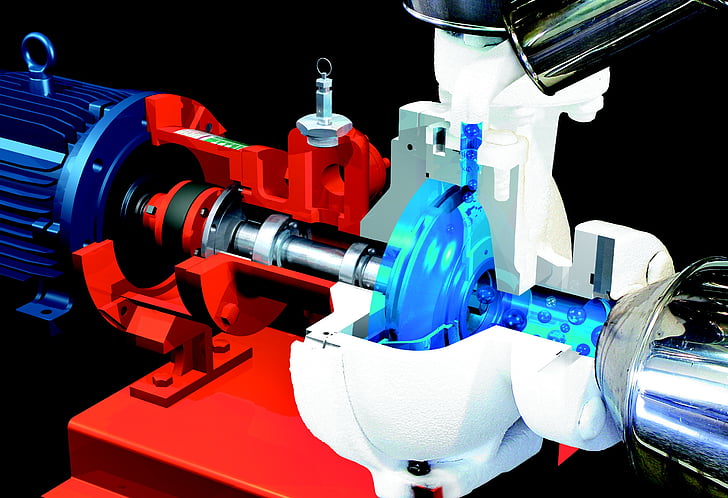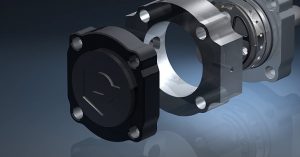Centrifugal pumps play a vital role in a variety of industrial applications as reliable and efficient fluid transfer tools. As industries strive to improve energy efficiency and performance, the choice of motor technology becomes critical. In recent years, permanent magnet synchronous motors (PMSMs) have emerged as an innovative solution for powering centrifugal pumps.

A centrifugal pump is a mechanical device that makes use of the principle of centrifugal force to transfer fluid from one point to another. Generally speaking, they apply in industries dealing with the processing of oil and gas, water treatment, chemical processing, and HVAC systems. Centrifugal pumps contain a number of key components which are integral to the operation of the pump. Probably the most critical component of the centrifugal pump is the impeller. This consists of a series of curved blades or blades mounted on a rotating shaft. The centrifugal force from rotation of the impeller serves to send the fluid radially outwards and upwards toward the housing. A lot is said about the impeller in design and configuration regarding efficiency and performance.
The casing is the stationary element in which the impeller is installed. The main role of this element is to gather the liquid leaving the impeller and to transform its kinetic energy into pressure energy with as little shock as possible. The shell-in fact, its spiral shape-reduces turbulence and takes part in smoothing the fluid flow.
Fluid initially enters the centrifugal pump via the suction inlet, where it initializes the pumping action. It then passes through an impeller, where energy and velocity are transferred to the fluid. It will then pass into the casing, where the velocity of the fluid will be reduced and increased in pressure. Finally, the fluid will exit the pump via the drain port and will continue to flow to the destination it is supposed to.
Seals are applied for the efficient operation of centrifugal pumps. Shaft seals avoid fluid leakage along a rotating shaft; this means, they make the pump operate efficiently without contamination or damage. The most widely used seals in a centrifugal pump are mechanical seals and gland packings.
Centrifugal pumps can be of different types depending on design and application. Single-stage pumps contain a single impeller, while multi-stage pumps contain a number of series-running impellers. Application examples are water circulation systems where this is required at low pressures, since large pressure values can be achieved from several stages, or in any kind of boiler feed pump applications.
Utilization of PMSMs in Centrifugal Pump Applications
Knowing the general structure and working principles of centrifugal pumps, it is also crucial to learn that the use of permanent magnet synchronous motors in centrifugal pump applications has really changed the efficiency and reliability of the fluid transfer system in all industries. Permanent magnet synchronous motors have become the first choice in driving centrifugal pumps due to sophisticated control and high energy efficiency in the water treatment, oil and gas, and mining industries.
Water treatment and water supply systems
In the processes of water treatment and water supply, these permanent magnet synchronous motors are very crucial in order to ensure timely and effective delivery of the treated water to communities and cities. Permanent magnet synchronous motors form part of the centrifugal pumping systems that transfer large volumes of treated water inside the pumping station or the water treatment plants. Permanent magnet synchronous motors have appropriate control capabilities for these systems to operate within demands for flow rates and pressure that vary. These systems, when installed in water treatment facilities, provide enormous amounts of energy savings and, correspondingly, reduce the operating costs of providing a continuous and dependable supply of water to the consumer.
Pumping systems for the oil and gas industry
Centrifugal pumps driven by permanent magnet synchronous motors have very important applications in the oil and gas industries for a wide range of fluid transfer applications. Applications of these are found at pumping stations, pipelines, or even onshore/offshore platforms since the permanent magnet synchronous motor gives high torque and good speed control for the arduous demands coming from crude oil, natural gas, and other fluids. In other words, since these permanent magnet synchronous motors are robust and reliable, such centrifugal pumps can be operationally efficient even in demanding ambient or operation conditions, thus increasing overall productivity and safety in an operating plant. Furthermore, energy efficiency via permanent magnet synchronous motors uses less power consumption according to the growing concerns that sustainability dictates an industry should be looking into seriously.
Mining and mineral processing
Centrifugal pumps driven by permanent magnet synchronous motors are viable in mining and mineral processing. Applications of mining operations include dewatering, transportation of slurries, and water supply. Permanent magnet synchronous motors are extremely efficient; hence, they may ensure cost-effective and reliable operation at even remote mining sites. The permanent magnet synchronous motor-driven pump has precision control capability to accommodate different slurry densities and flow rates, hence offering optimal performance and energy consumption. Permanent magnet synchronous motors have been applied in mining and mineral processing for efficiency in operations and resource management. Applications of PMSMs in centrifugal pumps are so huge in all industries due to unique advantages of energy efficiency, precision in control, and reliability in operation. The integration of permanent magnet synchronous motors changes the benchmark for fluid transportation with respect to extending performance and sustainability.

Key Considerations for PMSM Implementation
Following are some of the key factors that must be kept in mind while implementing a PMSM in a centrifugal pump system. These are some of those key factors that become quite vital in achieving the best performance of PMSMs in centrifugal pump systems. We are going to take you through a number of those potential challenges that might pop up in an implementation process, with solutions to get over them.
Motor selection
Proper sizing of the motor is important for efficient performance of permanent magnet synchronous motors in centrifugal pump systems.
Particularly, motors should be optimally sized to provide the required degree of torque, speed, and power for a given application. Undersizing motors will result in inefficiency, overheating, and, ultimately, early failure, while oversized motors reduce energy efficiency with higher costs. Determining the correct motor size is dependent upon the pump’s flow, head pressure, and system friction. This is best accomplished with the motor manufacturer or an engineer to ensure the appropriate size motor for the application is available. Control methods Permanent magnet synchronous motors have sophisticated control methods; it is possible to finely tune the motor speed and torque to offer superior operation in centrifugal pumps.
Control methods
The choice of the control method is dependent on the application, namely, whether the applications are constant or variable speed applications. Standard forms of control methods include scalar control and vector control. While scalar control is simple and inexpensive to implement for low-performance applications, vector control offers more sophisticated control; hence, it best fits high-performance applications. Selection of the appropriate control method shall also depend on the operating environment, power supply available, and system complexity among other design considerations.
Installation precautions
The reliability and efficiency of centrifugal pump systems depend on appropriate installation of the permanent magnet synchronous motors. Motors shall be positioned with regard to cooling and shall be aligned. The positioning of motors shall be optimized regarding good access, maintainability, and safety. Proper alignment reduces vibration and prevents premature bearing failure. Depending on the environment of operation and temperature conditions a motor will deal with, appropriate cooling by air or liquid cooling is observed. Installation shall be performed taking into consideration manufacturer recommendations and according to best practices, keeping in mind possible problems arising with regard to electrical noise, vibration, or efficiency reduction.
Potential challenges and solutions
A permanent magnet synchronous motor fitted to a centrifugal pump system does come with quite a few disadvantages that need to be overcome in pursuit of its optimum performance.
The first drawback is the susceptibility of electrical noise due to high switching frequency that might result in interference to other electrical equipment of the system.
The proper grounding and shielding techniques reduce the electrical noise and prevent interference.
Another problem is the motor overheating; this can be because of either insufficient cooling or improper sizing of the motor. Sufficient cooling and correct sizing of the motor can avoid overheating and prolong its life. In the Conclusion, Permanent magnet synchronous motors advanced control features, high energy efficiency, and reliable operation make them the first choice to drive centrifugal pumps. The permanent magnet synchronous motors in centrifugal pumps will play an important role in providing an energy-efficient, reliable, and sustainable transportation system. Further, the strong role that it could play in centrifugal pumps pertains mainly to the development of innovative global delivery systems because industries today consider shifting towards sustainability practices and energy efficiency.